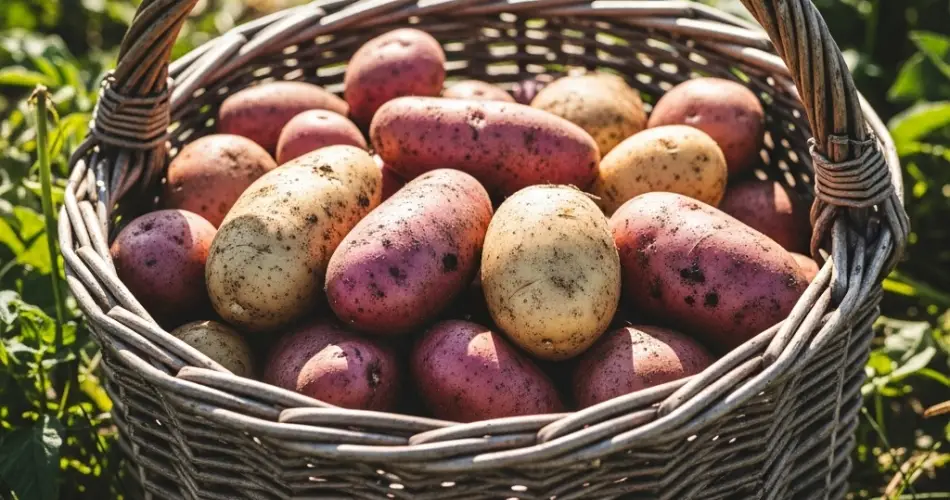Potatoes are a favorite crop for home gardeners thanks to their versatility, nutritional value, and ease of cultivation. But if you’re looking to get more harvest from a small space, one technique stands out: layered potato planting. This simple yet effective method maximizes the vertical growing potential of potatoes and can significantly increase your yield—especially in raised beds, grow bags, or containers.
Here’s everything you need to know about layered potato planting, from how it works to step-by-step instructions, plus essential tips for success.
What Is Layered Potato Planting?
Layered planting is a technique where seed potatoes are planted in multiple vertical layers within a container, grow bag, or deep raised bed. As the plants grow, more soil or compost is added in stages to encourage additional tuber formation along the buried stems.
Potatoes naturally produce tubers above the seed piece, not below it. By layering soil around the growing stems, you create more space for the plant to produce tubers at different heights—resulting in a larger harvest from the same footprint.
Benefits of Layered Planting
-
Maximizes space: Ideal for small gardens, balconies, or patios.
-
Increases yield: More tubers per plant due to extended growing area.
-
Minimizes weeding: Soil layering helps suppress weeds.
-
Improves soil conditions: Layering allows for better drainage and soil aeration.
-
Makes harvesting easier: Loose soil in containers or bags makes digging up potatoes simpler and less damaging.
Best Varieties for Layered Planting
While most potatoes can be grown in layers, some types are more productive when planted this way:
-
Second earlies and maincrop varieties like ‘Yukon Gold,’ ‘Kennebec,’ ‘Desiree,’ and ‘Russet’ tend to perform well.
-
Avoid determinate types (e.g., many fingerlings), as they don’t benefit as much from hilling or layering.
Look for varieties that grow vigorously and produce tubers along extended stems.
What You Need
-
Large container, grow bag, or raised bed (minimum 16–20 inches deep)
-
Seed potatoes, preferably certified disease-free
-
Loose, nutrient-rich soil or a mix of compost, potting soil, and aged manure
-
Mulch (optional, such as straw or dried leaves)
-
Water source
Step-by-Step Guide to Layered Potato Planting
1. Prepare the container or bed
Choose a deep container or raised bed with good drainage. Fill the bottom 4–6 inches with your prepared soil mix.
2. Plant the first layer
Place seed potatoes (with eyes facing up) directly onto the soil, spaced 6–8 inches apart. Cover them with 4 inches of soil.
3. Wait for growth
Allow shoots to grow until they are about 6–8 inches tall. At this point, begin layering.
4. Add the next soil layer
Gently add 3–4 more inches of soil around the plants, leaving the top few inches of leaves exposed. As the stems grow, continue to bury them, repeating the process every time they gain another 6 inches in height.
You can add 2–3 layers, depending on the depth of your container or bed. Stop layering once the soil is near the top edge or plants begin to flower.
5. Water consistently
Potatoes need regular moisture to develop properly. Keep the soil evenly moist but not waterlogged throughout the growing season. Containers dry out more quickly, so check soil moisture daily.
6. Feed occasionally
To maintain healthy growth, feed with a balanced organic fertilizer or compost tea every few weeks. Potatoes are heavy feeders, and layering dilutes soil nutrients over time.
When and How to Harvest
Potatoes are ready to harvest once the foliage turns yellow and begins to die back, usually 10–12 weeks after planting for early varieties and 16–20 weeks for maincrops.
To harvest:
-
Gently remove the top layers of soil.
-
Hand-pick tubers as you go down each layer.
-
For container-grown potatoes, tip the entire container and sift through the soil.
Harvest gradually if you prefer “new potatoes,” or wait until full maturity for larger storage tubers.
Tips for Success
-
Use clean seed potatoes to reduce the risk of disease.
-
Avoid overwatering—soggy soil can lead to rot.
-
Provide full sun for at least 6–8 hours daily.
-
Rotate crops each season to reduce soil-borne pests and disease.
-
Protect young plants from frost by covering them if cold weather is expected.
Final Thoughts
Layered potato planting is a smart, space-saving technique that helps maximize yield with minimal effort. Whether you’re growing in bags on a balcony or deep beds in the garden, this method offers a reliable way to grow more food in less space. With proper care, consistent watering, and the right timing, you’ll be rewarded with a bountiful potato harvest that tastes far better than anything store-bought.
So if you’re looking to boost your potato yield this season, try layering—you’ll be surprised by how much you can grow in a small vertical space.



